Rice Kefiran is a novel, low-fat, highly functional food. Original Kefiran is the main component of kefir, a traditional fermented milk with historical roots in the Caucasus region. The people of Caucasus have been known for their exceptional longevity, which was attributed to this popular kefir drink. Kefir is a fermented milk beverage that is produced using a starter of yeasts and lactobacilli complexes, called kefir grains. Kefir contains alcohol, lactic acid, and carbon dioxide and has a distinct flavor which is appreciated in Eastern Europe and countries of the former Soviet Union, where 1.2 million tons of kefir are produced annually. Moreover, kefir is valued not only as a delicious beverage, but is also plazed as a macrobiotic food that helps to maintain and promote overall health. Rice Kefiran is a breakthrough Kefiran product made not from dairy, an animal source, but from rice, a vegetable source. Manufacturing Kefiran from a vegetable source is made possible only by Daiwa's state of the art biotechnology. To create Rice Kefiran, the lactobacilli, L.kefiranofaciens are separated from kefir and made into a pure culture in rice ingredients, thus enhancing the macrobiotic value.
Doctor Recommended
"The extraordinary combination of lactobacilli and rice creates a health food derived from Japan's staple food"
Tomotari Mitsuoka
Professor Emeritus of the University of Tokyo
Doctor of Agriculture
Professor Emeritus of the University of Tokyo
Doctor of Agriculture

A traditional type of sushi with a unique flavor, Narezushi, is produced in Japan by fermenting river fish in salt and a grain such as rice, to preserve the food. This is the precursor of modern sushi, and is an example of the excellent synergy between rice and lactobacilli. Until recently, lactobacillus (L.kefiranofaciens) has been cultured in milk, and typically, rice has not been the principal raw material for fermentation. A new, innovative technology uses bacteria and rice to produce Kefiran, a viscous polysaccharide.
As an expert in assigning the nomenclature and classification of lactobacilli, I am familiar with the challenge of large-scale culturing. I am pleased that large-scale cultivation is now available, making it possible for Kefiran to be incorporated into foods. It is remarkable to have opportunity to enhance people's health worldwide with the production of this novel food from Japan. My hope is that Rice Kefiran will become widely accepted based on its reputation for preventing lifestyle-related diseases.
Development Background
The fermented milk, kefir, contains biogenic elements that directly affect metabolism and tissues, with other components that indirectly enhance biological functions by acting on intestinal bacteria. Examples of biogenic components are Kefiran (a viscous polysaccharide) and lactic acid. Examples of the other components are lactobacilli, their cell components, and bacteriocin, a type of antibacterial substance produced by lactobacilli. Kefir is an amazing food that has been reported to improve the intestinal environment and liver function, prevent arteriosclerosis, and strengthen immune function. These health benefits of kefir are thought to be derived from a functional component. However, making kefir widely popular in Japan has some slight problems: (1) kefir contains alcohol, (2) it produces carbon dioxide during storage, and (3) its flavor does not suit Japanese taste-preferences. If a new functional food ingredient could be developed from kefir with improved flavor and enhanced functional components, it is believed that it could become widely popular in Japan and throughout the world. With this in mind, the development of Rice Kefiran was advanced.
Development
The lactobacillus L.kefiranofaciens, which forms the kefir grains, is thought to play a major role in the functionality of kefir. L.kefiranofaciens has been isolated from kefir grains, and was named by Japanese researcher Dr. Tomotari Mitsuoka.
The viscous polysaccharide Kefiran is believed to be the main functional component of the health drink kefir, and L.kefiranofaciens produces Kefiran. This homofermentative lactobacillus produces lactic acid only, so no alcohol or carbon dioxide is created. Thus, by using only L.kefiranofaciens for lactic acid fermentation, the problems with kefir were resolved, and its functionality is enhanced. Large-scale culturing of this bacterium is difficult and had been unsuccessful in the past, but with the assistance of Ministry of Agriculture, Forestry and Fisheries, Daiwa has developed a method of culturing the bacterium using rice as a source of nutrients by means of innovative technology that produces stable Rice Kefiran.
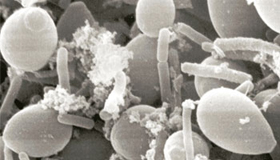
Scanning electron micrograph of the surface of kefir grains. Yeast and Lactobacilli coexist.
(“Science and Technology of Lactobacilli”, edited by Japanese Study Group for Lactic Acid Bacteria, 1996, Japan Scientific Societies Press) .
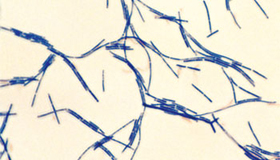
Micrograph of Gram staining L.kefiranofaciens
(Daiwa Pharmaceutical Co., Ltd.).
Characteristics
• Has a high concentration of Kefiran, a viscous polysaccharide
• Is low in fat because it is made from fermented rice using lactic acid
• Contains no carbon dioxide or alcohol because it is a pure product of homolactic fermentation
• Is the first lactobacilli culture produced using L.kefiranofaciens
• Contains many amino acid-related substances derived from rice
Comparison of the components of Rice Kefiran and Kefir (per 100g)
| Rice Kefiran | Homemade kefir | |
| Kefiran content | 500mg or more | 2mg |
| Fat | < 0.5g | 2.8 – 3.3g |
| Alcohol | 0g | 0.6 – 1.1g |
Suggested daily dose
400mg or more/day
Function
1. Functional Components
The main functional component of Rice Kefiran is the viscous polysaccharide Kefiran. 100 g of Rice Kefiran contains 500 mg or more of Kefiran.
This is about 250 times the amount in 100 g of homemade kefir, which contains about 2 mg of Kefiran. Rice Kefiran also contains rice peptides, produced by lactobacilli, and gamma-aminobutyric acid (GABA).
This is about 250 times the amount in 100 g of homemade kefir, which contains about 2 mg of Kefiran. Rice Kefiran also contains rice peptides, produced by lactobacilli, and gamma-aminobutyric acid (GABA).
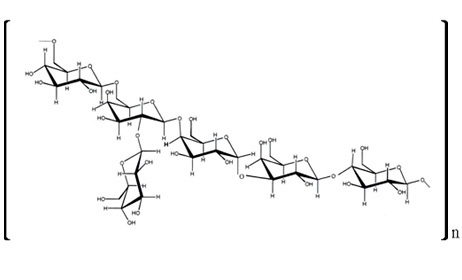
2. Mechanism of Action
Rice Kefiran is a water-soluble indigestible polysaccharide (a type of dietary fiber) which improves the intestinal environment and regulates blood lipids and blood sugar levels. In addition, Rice Kefiran contains GABA and rice peptides, which probably contribute to blood pressure and blood sugar regulation.
In addition to Kefiran's role as dietary fiber, the antibacterial effect of peptides produced by L.kefiranofaciens may also contribute to improving the intestinal environment. Animal studies using Rice Kefiran have detected a constituent sugar of Kefiran, known as galactose, in the serum lipid β-VLDL, indicating that some Kefiran is absorbed and utilized by the body.
Scientific Data (SD)
- Anti-arteriosclerotic effect
- Anti-allergic effect
- Antihyperglycemic effect
- Regulation of intestinal function
- Improvement of intestinal environment
- Improvement of liver function
- Improvement of hay fever symptoms
Safety
| Single dose | LD50>5000mg/kg |
| Repeated dose | NOAEL>1000mg/kg/day |
| Mutagenicity (Ames test) | Negative with and without S9 mix |
Assays
Rabbit anti-Kefiran antibody is prepared, and a sandwich enzyme-linked immunosorbent assay (ELISA) is used to measure the amount of antigen corresponding to Kefiran-specific antibodies. The measured value indicates the weight of the functional ingredient.
SD1. Anti-arteriosclerotic effect
In a study of rabbits with experimentally induced atherosclerosis* with a high-cholesterol diet, Rice Kefiran ingestion was shown to inhibit the formation of aortic atherosclerosis. Compared with a group that ate a standard diet, the group that ate Rice Kefiran in addition to the standard diet, had significantly reduced levels of the lipid peroxides β-VLDL (“bad” cholesterol) in the blood. In addition, when the monosaccharide content in the β-VLDL was compared between the Rice Kefiran group and the standard diet group, the Rice Kefiran group showed significantly higher levels of glucose and galactose, which are constituent sugars of Kefiran. Based on these results, Kefiran, the active ingredient of Rice Kefiran, is believed to be absorbed via the gastrointestinal tract and to have anti-arteriosclerotic effects. Kefiran, therefore, has a clear biogenic function.
* Atherosclerosis is a type of arteriosclerosis in which foreign bodies, such as lipids and cholesterols, move sluggishly through arteries and build up in the inner layers, forming what are called atheromas.
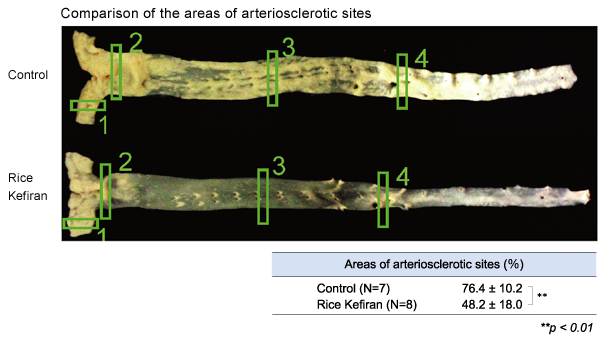
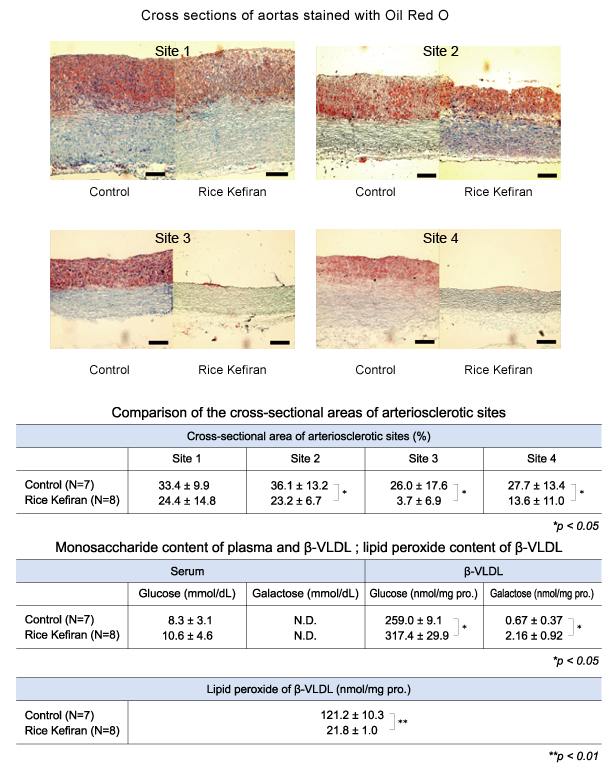
Uchida M, Ishii I, Inoue C. et. al. 2010. “Kefiran Reduces Atherosclerosis in Rabbit Fed a High Cholesterol Diet”, Journal of Atherosclerosis and Thrombosis, 17 (9), 980-988 .
SD2.Anti-allergic effect
A type I allergic reaction was induced by applying a mixture of acetone and olive oil containing dinitrophenyl benzene (DNFB) to the ears of mice to which anti-DNP-IgE had previously administered intravenously. Compared with a control group (mice not treated with Rice Kefiran) mice that were fed 250 mg/kg of Rice Kefiran per day for 14 days showed suppressed type I allergic reactions. The control group also showed a delayed allergic reaction 24 hours after the induced reaction, while the group treated with Rice Kefiran did not.
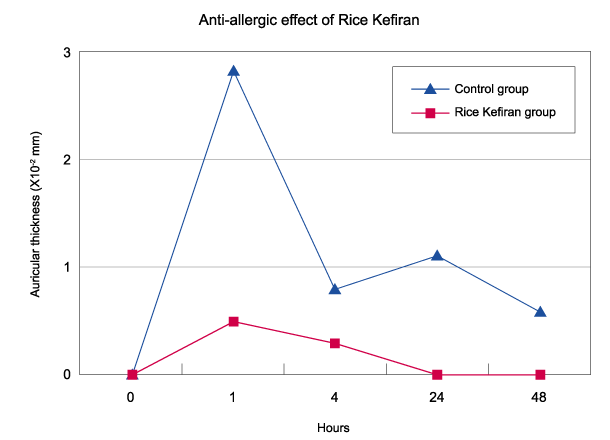
Company data of Daiwa Pharmaceutical Co., Ltd.
SD3. Antihyperglycemic effect
The antihyperglycemic effect of orally administered Kefiran was examined using spontaneously diabetic 8-week-old male KKAy mice. The treatment lasted for 30 days. Blood glucose levels were measured before treatment and on days 15 and 30. After the start of treatment, chronological changes in blood glucose levels at satiety measured on days 15 and 30 showed that the control group mice were hyperglycemic throughout the study. However, in the two groups that were administered Kefiran, suppression of blood sugar elevation was observed on days 15 and 30, and on day 30, the group that was administered 300 mg/kg of Kefiran showed significantly lower spikes. In a manner similar to the satiety test, the fasting blood sugar levels also showed lower values for the two groups treated with Kefiran as compared to the control group.
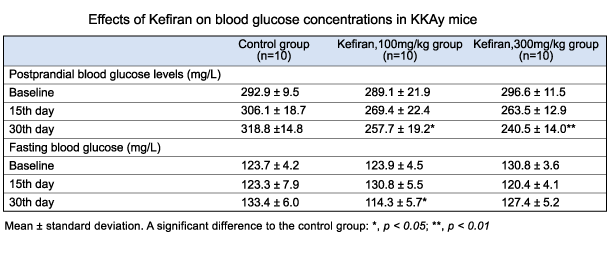
Maeda H., Zhu X. and T. Mitsuoka. 2004. “Effects of an Exopolysaccharide (Kefiran) from Lactobacillus kefiranofaciens on Blood Glucose in KKAy Mice and Constipation in SD Rats Induced by a Low-Fiber Diet”, Bioscience and Microflora, 23(4), 149-153 .
SD4. Regulation of intestinal function
To examine the effect of Kefiran on intestinal function, constipation was induced in 6-week-old male SD rats by feeding them a low-fiber diet for 21 days. Starting on day 22, Kefiran was administered for 14 days. Throughout this treatment, the rats freely ate a low-fiber diet. Before starting treatment and on days 7 and 14, naturally excreted fresh droppings were collected, and their weight and moisture content were measured.
The fecal weight and moisture content were found to significantly increase depending on the concentration of Kefiran. Gross observations made during autopsies after the end of the study showed that hardened feces had accumulated in the colons of the control group mice but not in those of the mice in the groups treated with Kefiran.
The fecal weight and moisture content were found to significantly increase depending on the concentration of Kefiran. Gross observations made during autopsies after the end of the study showed that hardened feces had accumulated in the colons of the control group mice but not in those of the mice in the groups treated with Kefiran.
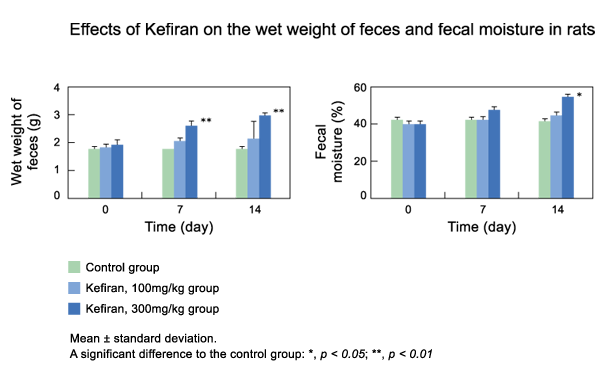
Maeda H., Zhu X. and T. Mitsuoka. 2004. “Effects of an Exopolysaccharide (Kefiran) from Lactobacillus kefiranofaciens on Blood Glucose in KKAy Mice and Constipation in SD Rats Induced by a Low-Fiber Diet”, Bioscience and Microflora, 23(4), 149-153 .
SD5. Improvement of intestinal environment
Rice Kefiran was administered to rats whose intestinal environments had been aggravated by high cholesterol diets, and changes in the intestinal environment were measured using histamine content in the feces and cecal content as an indicator. An increase of histamine in the intestine indicates aggravation of the intestinal environment.
Compared to the control group, the feces and cecal content of the groups fed diets containing 1.5 and 3.0% Rice Kefiran had significantly lower concentrations of histamine. These results suggest that Rice Kefiran improves the intestinal environment.
Compared to the control group, the feces and cecal content of the groups fed diets containing 1.5 and 3.0% Rice Kefiran had significantly lower concentrations of histamine. These results suggest that Rice Kefiran improves the intestinal environment.

Maeda H., Mizumoto H., Suzuki M. and K. Tsuji. 2005. “Effects of Kefiran-Feeding on Fecal Cholesterol Excretion, Hepatic Injury and Intestinal Histamine Concentration in Rats”, Bioscience and Microflora, 24(2), 35-40.
SD6. Improvement of liver function
Rats were fed a high cholesterol diet; they exhibited symptoms of high cholesterol and fatty livers, and deterioration in liver function was observed. In both groups treated with 1.5 and 3.0% Rice Kefiran, transaminase (GOT, GPT) activity was significantly reduced. These results suggest that Rice Kefiran acts to improve liver function.
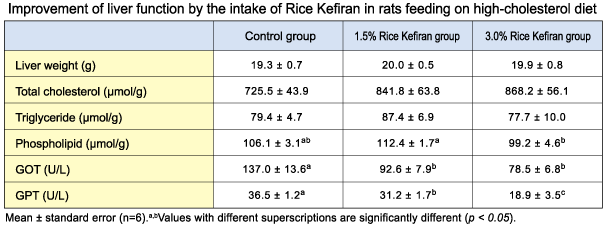
Maeda H., Mizumoto H., Suzuki M. and K. Tsuji. 2005. “Effects of Kefiran-Feeding on Fecal Cholesterol Excretion, Hepatic Injury and Intestinal Histamine Concentration in Rats”, Bioscience and Microflora, 24(2), 35-40.
SD7. Improvement of hay fever symptoms in humans
Seven men and women with hay fever, in their 20s through 60s were divided into two groups and observed for 8 weeks, during which they ingested a 1.5 g mixed sample that mainly consisted of 500 mg of Rice Kefiran and (heat killed) lactobacilli. The first group ingested the sample daily for the first four weeks of the study, and the second group ingested it during the last four weeks. When the subjects were not ingesting the samples, they were only observed. No relationship with the amount of pollen in the air was observed, but hay fever symptoms in both groups were less severe when the subjects were ingesting the Rice Kefiran sample compared to when they were not.
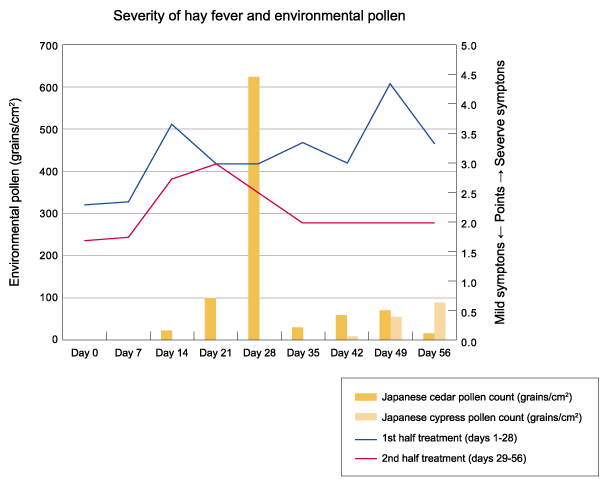
Company data of Daiwa Pharmaceutical Co., Ltd.
A traditional type of sushi with a unique flavor, Narezushi, is produced in Japan by fermenting river fish in salt and a grain such as rice, to preserve the food. This is the precursor of modern sushi, and is an example of the excellent synergy between rice and lactobacilli. Until recently, lactobacillus (L.kefiranofaciens) has been cultured in milk, and typically, rice has not been the principal raw material for fermentation. A new, innovative technology uses bacteria and rice to produce Kefiran, a viscous polysaccharide.
As an expert in assigning the nomenclature and classification of lactobacilli, I am familiar with the challenge of large-scale culturing. I am pleased that large-scale cultivation is now available, making it possible for Kefiran to be incorporated into foods. It is remarkable to have opportunity to enhance people's health worldwide with the production of this novel food from Japan. My hope is that Rice Kefiran will become widely accepted based on its reputation for preventing lifestyle-related diseases.
Development Background
The fermented milk, kefir, contains biogenic elements that directly affect metabolism and tissues, with other components that indirectly enhance biological functions by acting on intestinal bacteria. Examples of biogenic components are Kefiran (a viscous polysaccharide) and lactic acid. Examples of the other components are lactobacilli, their cell components, and bacteriocin, a type of antibacterial substance produced by lactobacilli. Kefir is an amazing food that has been reported to improve the intestinal environment and liver function, prevent arteriosclerosis, and strengthen immune function. These health benefits of kefir are thought to be derived from a functional component. However, making kefir widely popular in Japan has some slight problems: (1) kefir contains alcohol, (2) it produces carbon dioxide during storage, and (3) its flavor does not suit Japanese taste-preferences. If a new functional food ingredient could be developed from kefir with improved flavor and enhanced functional components, it is believed that it could become widely popular in Japan and throughout the world. With this in mind, the development of Rice Kefiran was advanced.
Development
The lactobacillus L.kefiranofaciens, which forms the kefir grains, is thought to play a major role in the functionality of kefir. L.kefiranofaciens has been isolated from kefir grains, and was named by Japanese researcher Dr. Tomotari Mitsuoka.
The viscous polysaccharide Kefiran is believed to be the main functional component of the health drink kefir, and L.kefiranofaciens produces Kefiran. This homofermentative lactobacillus produces lactic acid only, so no alcohol or carbon dioxide is created. Thus, by using only L.kefiranofaciensfor lactic acid fermentation, the problems with kefir were resolved, and its functionality is enhanced. Large-scale culturing of this bacterium is difficult and had been unsuccessful in the past, but with the assistance of Ministry of Agriculture, Forestry and Fisheries, Daiwa has developed a method of culturing the bacterium using rice as a source of nutrients by means of innovative technology that produces stable Rice Kefiran.
Comparison of the components of Rice Kefiran
and Kefir (per 100g)
| Rice Kefiran | Homemade kefir | |
| Kefiran content | 500mg or more | 2mg |
| Fat | < 0.5g | 2.8 – 3.3g |
| Alcohol | 0g | 0.6 – 1.1g |
Suggested daily dose
400mg or more/day
Function
1. Functional Components
The main functional component of Rice Kefiran is the viscous polysaccharide Kefiran. 100 g of Rice Kefiran contains 500 mg or more of Kefiran.
This is about 250 times the amount in 100 g of homemade kefir, which contains about 2 mg of Kefiran. Rice Kefiran also contains rice peptides, produced by lactobacilli, and gamma-aminobutyric acid (GABA).
This is about 250 times the amount in 100 g of homemade kefir, which contains about 2 mg of Kefiran. Rice Kefiran also contains rice peptides, produced by lactobacilli, and gamma-aminobutyric acid (GABA).

2. Mechanism of Action
Rice Kefiran is a water-soluble indigestible polysaccharide (a type of dietary fiber) which improves the intestinal environment and regulates blood lipids and blood sugar levels. In addition, Rice Kefiran contains GABA and rice peptides, which probably contribute to blood pressure and blood sugar regulation.
In addition to Kefiran's role as dietary fiber, the antibacterial effect of peptides produced by L.kefiranofaciens may also contribute to improving the intestinal environment. Animal studies using Rice Kefiran have detected a constituent sugar of Kefiran, known as galactose, in the serum lipid β-VLDL, indicating that some Kefiran is absorbed and utilized by the body.
Scientific Data
- Anti-arteriosclerotic effect
- Anti-allergic effect
- Antihyperglycemic effect
- Regulation of intestinal function
- Improvement of intestinal environment
- Improvement of liver function
- Improvement of hay fever symptoms
Safety
| Single dose | LD50>5000mg/kg |
| Repeated dose | NOAEL>1000mg/kg/day |
| Mutagenicity (Ames test) | Negative with and without S9 mix |
Assays
Rabbit anti-Kefiran antibody is prepared, and a sandwich enzyme-linked immunosorbent assay (ELISA) is used to measure the amount of antigen corresponding to Kefiran-specific antibodies. The measured value indicates the weight of the functional ingredient.

No comments:
Post a Comment